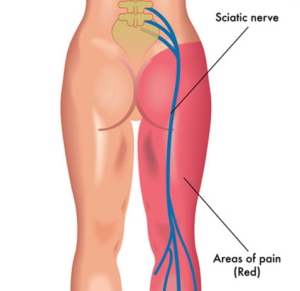What is Sciatica?
Sciatica describes a collection of symptoms that can arise with sciatic nerve compression. This nerve is the largest and longest in the body, running from the base of the spine and down through both legs. Sciatic nerve compression can lead to pain that begins in the lower back and moves through the buttocks, legs, and feet. It is also characterized by other symptoms like burning, cramping, muscle weakness, tingling, and numbness. Sciatica generally occurs on one side of the body, but it can affect both sides.
The sciatic nerve is about an inch wide and consists of multiple nerve bundles. Sciatica is produced when this nerve is being compressed or pinched. Compression is often caused by a herniated disc or a bone spur, most commonly in the area where the nerve passes out of the spinal column in the lumbar (lower back) region.
Most sciatica treatment methods are nonsurgical. These methods include brief periods of rest, specialized exercises and stretching, physical therapy and nonsteroidal anti-inflammatory drugs (NSAIDs). However, in some cases, these conservative treatments only provide temporary relief, leading some patients to explore surgery as an option. Today, sciatica can be addressed if you are a candidate for the minimally invasive spine procedures offered at Laser Spine Institute. In many cases, these outpatient procedures render highly invasive open back surgeries unnecessary.

Sciatica Causes
Sciatica, a form of nerve dysfunction (peripheral neuropathy), occurs when there is compression on, or damage to, the sciatic nerve. This nerve innervates the muscles behind the knee and lower leg. It provides sensation to the back of the thigh, part of the lower leg and the sole of the foot.
Sciatica arises most frequently because of pressure being placed on the sciatic nerve caused by a degenerative spine condition such as a herniated disc, a bulging disc, a protruding disc or a bone spur. The condition often is diagnosed as radiculopathy. This means that the damaged disc or excess growth of bone is positioned in such a way that it places pressure on the nerve root.
Sciatica might also be caused by an injury, including a fracture of the pelvis or trauma to the buttocks or thigh. Another factor could be prolonged external pressure on the nerve, and pressure on the nerve from nearby anatomical structures, including certain muscles. Sciatica might also arise in cases of nerve entrapment, which entails pressure on the nerve where it passes through an opening (foramen) between two vertebrae to exit the spinal column. The underlying cause of the symptoms is the prevention of the passage of proper motor and sensory impulses along the length of the nerve.
Diseases that affect the entire body, such as diabetes, can damage many different nerves, including the sciatic nerve. The sciatic nerve also may be harmed by pressure from a tumor, abscess or by bleeding in the pelvis.
Sciatica Symptoms
Sciatica symptoms include:
- sensation changes
- numbness
- tingling
- burning
- pain in the buttocks, down the back of the legs and/or into the soles of the feet
Sciatica can also cause weakness in the legs, knees, and feet, and in severe cases, it can cause a loss of mobility. In many cases, sciatica affects just the right or left side of the body, but it can affect both.
Sciatica Risk Factors
While sciatica is related to the natural aging process, which cannot be avoided, there are a number of activities that can increase the likelihood that a person develops the condition.
Sciatica risk factors include:
- Smoking cigarettes or consuming alcohol excessively
- Engaging in a sedentary lifestyle
- Participating in high-impact sports or exercise
- Engaging in repetitive physical activities, like lifting boxes
- Carrying excess body mass
- Injury
Taking steps to avoid or cease these behaviors can lead to tangible improvements in your spine health that can relieve pain and improve mobility. For example, a diet and exercise plan designed to help a patient lose weight while strengthening core muscles can take pressure off the lower spine and potentially relieve sciatic nerve compression.
Treatment of Sciatica
The procedures offered for sciatica is discectomy, a foraminotomy or a laminotomy — are for people with a herniated disc, bulging disc or bone spur that is pressing on the sciatic nerve and causing the symptoms of sciatica. By removing or shrinking the herniated disc or bulging disc with a laser, we can decompress the nerve.